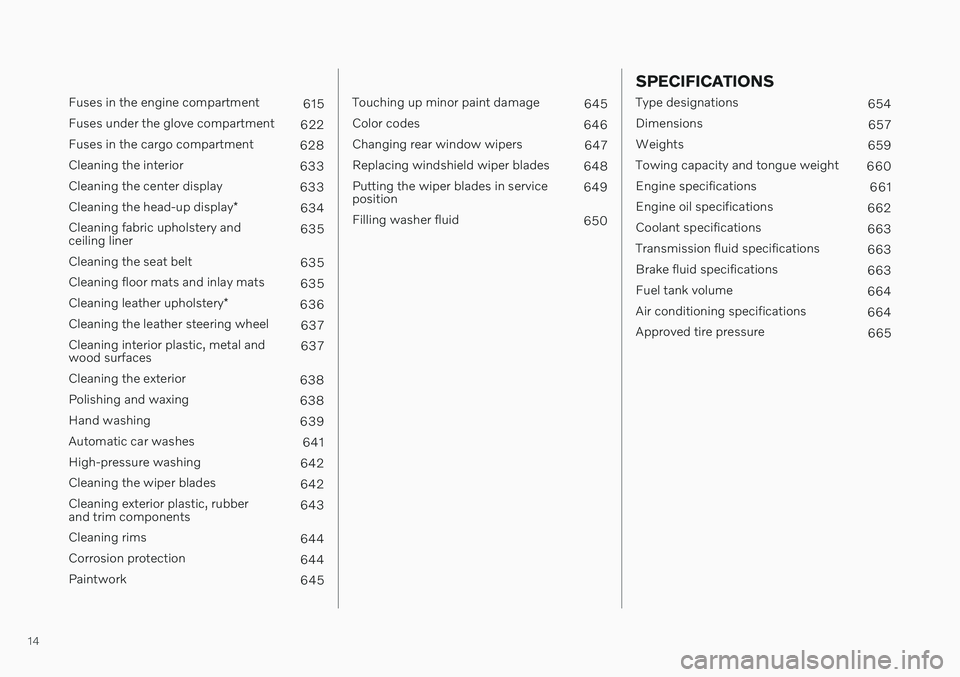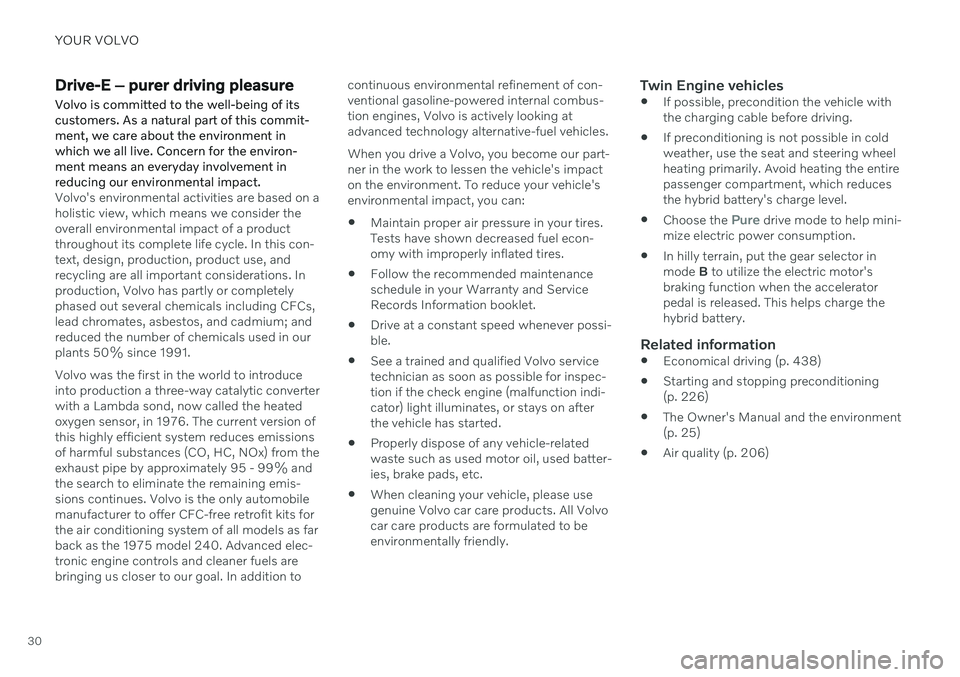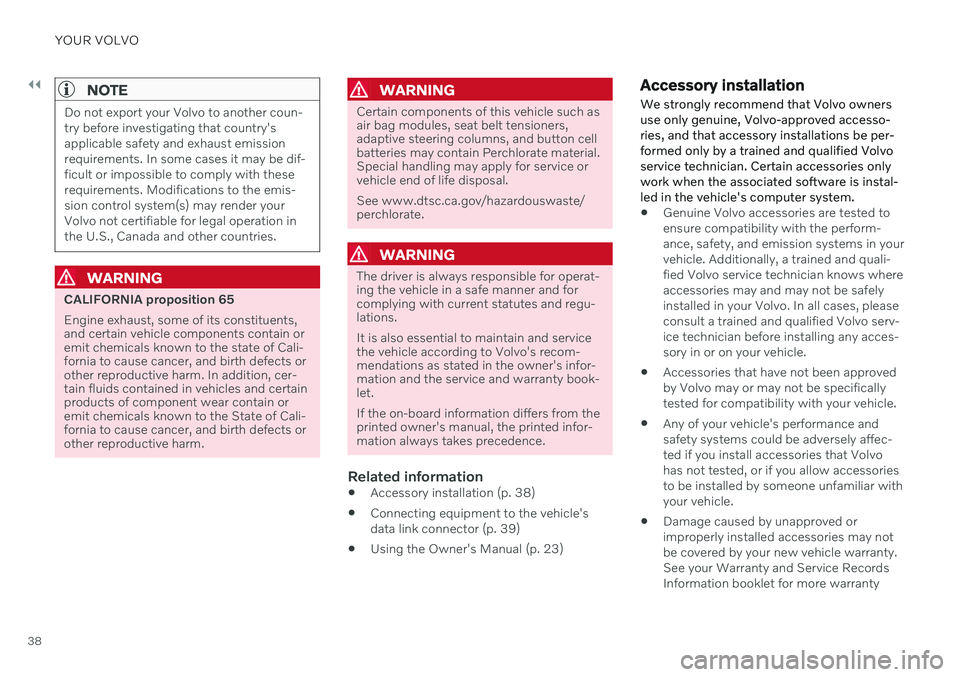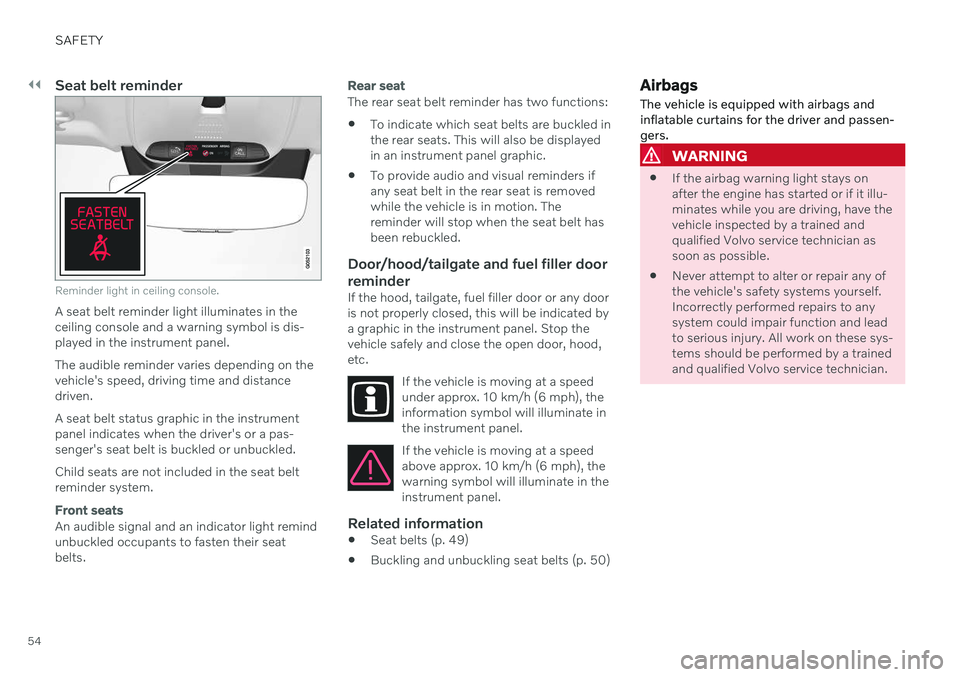engine VOLVO XC60 TWIN ENGINE 2020 Owners Manual
[x] Cancel search | Manufacturer: VOLVO, Model Year: 2020, Model line: XC60 TWIN ENGINE, Model: VOLVO XC60 TWIN ENGINE 2020Pages: 687, PDF Size: 14.65 MB
Page 11 of 687

9
Activating or deactivating Park Assist*
363
Park Assist limitations 363
Park Assist symbols and messages 365
Park Assist Camera *
366
Location and field of vision of Park Assist Cameras * 367
Park Assist Camera trajectory lines *
369
Park Assist sensor field 371
Activating Park Assist Camera 372
Park Assist Camera symbols and messages 374
Park Assist Pilot *
375
Types of parking with Park Assist Pilot * 376
Using Park Assist Pilot *
377
Leaving a parallel parking spacewith Park Assist Pilot *379
Park Assist Pilot * limitations
380
Park Assist Pilot * messages
382
HYBRID INFORMATION
General information about Twin Engine 384
Charging the hybrid battery 385
Charging current 387
Charge cable 387
Charging cable residual current device 389
Charging cable temperature moni-toring 390
Opening and closing the chargingsocket cover 390
Initiating hybrid battery charging 390
Charging status in the vehicle'scharging socket 392
Charging status in the chargingcable's charging module 393
Charging status in the instrumentpanel 394
Stopping hybrid battery charging 396
Twin Engine symbols and mes-sages in the instrument panel 397
Long-term storage of vehicleswith hybrid batteries 399
STARTING AND DRIVING
Starting the vehicle
402
Switching off the vehicle 404
Ignition modes 405
Selecting ignition mode 406
Brake functions 407
Brakes 407
Brake Assist System 409
Braking on wet roads 410
Braking on salted roads 410
Maintenance of the brake system 410
Parking brake 411
Activating and deactivating the parking brake 411
Settings for automatically activat-ing the parking brake 413
Parking on a hill 413
Parking brake malfunction 413
Auto-hold brakes 414
Activating and deactivating Auto-hold at a standstill 415
Hill Start Assist 416
Braking assist after a collision 416
Transmission 416
Automatic transmission 417
Gear selector positions for auto-matic transmissions 418
Page 12 of 687

10
Using the steering wheel paddles*
to shift 419
Shiftlock 420
The kickdown function 421
All Wheel Drive (AWD) 421
Drive systems 422
Starting and stopping the com- bustion engine in Twin Enginevehicles 423
Drive modes 423
Changing drive mode 428
Energy distribution in hybrid mode using map data *429
Leveling control * and suspension
430
Leveling control settings *
433
Adjusting suspension settingsPolestar Engineered * 433
Low Speed Control 435
Activating and deactivating Low Speed Control using the functionbutton 436
Hill Descent Control 436
Activating and deactivating HillDescent Control using the func-tion button 437
Economical driving 438
Factors affecting electric motor range 439
Hold and Charge functions 441
Preparing for a long trip442
Winter driving 442
Driving through standing water 443
Opening/closing the fuel filler door 444
Refueling 445
Fuel 446
Octane rating 447
Emission controls 449
Overheating of engine and trans- mission 450
Battery drain 451
Jump starting using another battery 451
Retractable hitch *
453
Detachable towbar *
455
Driving with a trailer 457
Trailer Stability Assist *
459
Checking trailer lights 460
Towing using a towline 461
Attaching and removing the tow-ing eyelet 461
Recovery 462
HomeLink ®
* 463
Programming HomeLink ®
* 464
Using HomeLink ®
* 466
Type approval for HomeLink ®
* 466
Compass*
467
Activating and deactivating the compass * 467
Calibrating the compass *
468
Page 15 of 687

13
Snow chains560
Tire sealing system 561
Using the tire sealing system 562
Inflate tires with the compressor included in the tire sealing system 565
Determining the vehicle's permit-ted weight 566
LOADING, STORAGE AND PASSENGER COMPARTMENT
Passenger compartment interior
570
Tunnel console 571
Electrical outlets 572
Using the electrical outlets 574
Using the glove compartment 575
Sun visors 577
Cargo compartment 577
Loading recommendations 577
Roof loads and load carriers 579
Grocery bag holders 579
Load anchoring eyelets 580
Rear seat ski hatch 580
Installing and removing the cargo compartment cover * 581
Operating the cargo compartmentcover * 583
Installing and removing the steelcargo grid * 584
Installing and removing the cargo net *
586
MAINTENANCE AND SERVICE
Volvo's service program
590
Data transfer between vehicle and workshop over Wi-Fi 593
Download Center 593
Handling system updates viaDownload Center 594
Vehicle status 595
Scheduling service and repairs 595
Sending vehicle information to theworkshop 596
Hoisting the vehicle 597
Climate control system service 599
Replacing a windshield with head- up display * 599
Opening and closing the hood 599
Engine compartment overview 601
Engine oil 602
Checking and filling engine oil 603
Refilling coolant 604
Replacing bulbs 606
Start battery 607
Hybrid battery 611
Battery symbols 612
Battery recycling 612
Fuses and fuseboxes 613
Replacing fuses 613
Page 16 of 687

14
Fuses in the engine compartment615
Fuses under the glove compartment 622
Fuses in the cargo compartment 628
Cleaning the interior 633
Cleaning the center display 633
Cleaning the head-up display *
634
Cleaning fabric upholstery and ceiling liner 635
Cleaning the seat belt 635
Cleaning floor mats and inlay mats 635
Cleaning leather upholstery *
636
Cleaning the leather steering wheel 637
Cleaning interior plastic, metal andwood surfaces 637
Cleaning the exterior 638
Polishing and waxing 638
Hand washing 639
Automatic car washes 641
High-pressure washing 642
Cleaning the wiper blades 642
Cleaning exterior plastic, rubberand trim components 643
Cleaning rims 644
Corrosion protection 644
Paintwork 645
Touching up minor paint damage645
Color codes 646
Changing rear window wipers 647
Replacing windshield wiper blades 648
Putting the wiper blades in service position 649
Filling washer fluid 650
SPECIFICATIONS
Type designations 654
Dimensions 657
Weights 659
Towing capacity and tongue weight 660
Engine specifications 661
Engine oil specifications 662
Coolant specifications 663
Transmission fluid specifications 663
Brake fluid specifications 663
Fuel tank volume 664
Air conditioning specifications 664
Approved tire pressure 665
Page 32 of 687

YOUR VOLVO
30
Drive-E ‒ purer driving pleasure
Volvo is committed to the well-being of its customers. As a natural part of this commit-ment, we care about the environment inwhich we all live. Concern for the environ-ment means an everyday involvement inreducing our environmental impact.
Volvo's environmental activities are based on a holistic view, which means we consider theoverall environmental impact of a productthroughout its complete life cycle. In this con-text, design, production, product use, andrecycling are all important considerations. Inproduction, Volvo has partly or completelyphased out several chemicals including CFCs,lead chromates, asbestos, and cadmium; andreduced the number of chemicals used in ourplants 50% since 1991. Volvo was the first in the world to introduce into production a three-way catalytic converterwith a Lambda sond, now called the heatedoxygen sensor, in 1976. The current version ofthis highly efficient system reduces emissionsof harmful substances (CO, HC, NOx) from theexhaust pipe by approximately 95 - 99% andthe search to eliminate the remaining emis-sions continues. Volvo is the only automobilemanufacturer to offer CFC-free retrofit kits forthe air conditioning system of all models as farback as the 1975 model 240. Advanced elec-tronic engine controls and cleaner fuels arebringing us closer to our goal. In addition to continuous environmental refinement of con-ventional gasoline-powered internal combus-tion engines, Volvo is actively looking atadvanced technology alternative-fuel vehicles. When you drive a Volvo, you become our part- ner in the work to lessen the vehicle's impacton the environment. To reduce your vehicle'senvironmental impact, you can:
Maintain proper air pressure in your tires.Tests have shown decreased fuel econ-omy with improperly inflated tires.
Follow the recommended maintenanceschedule in your Warranty and ServiceRecords Information booklet.
Drive at a constant speed whenever possi-ble.
See a trained and qualified Volvo servicetechnician as soon as possible for inspec-tion if the check engine (malfunction indi-cator) light illuminates, or stays on afterthe vehicle has started.
Properly dispose of any vehicle-relatedwaste such as used motor oil, used batter-ies, brake pads, etc.
When cleaning your vehicle, please usegenuine Volvo car care products. All Volvocar care products are formulated to beenvironmentally friendly.
Twin Engine vehicles
If possible, precondition the vehicle withthe charging cable before driving.
If preconditioning is not possible in coldweather, use the seat and steering wheelheating primarily. Avoid heating the entirepassenger compartment, which reducesthe hybrid battery's charge level.
Choose the
Pure drive mode to help mini-
mize electric power consumption.
In hilly terrain, put the gear selector in mode
B to utilize the electric motor's
braking function when the acceleratorpedal is released. This helps charge thehybrid battery.
Related information
Economical driving (p. 438)
Starting and stopping preconditioning(p. 226)
The Owner's Manual and the environment(p. 25)
Air quality (p. 206)
Page 40 of 687

||
YOUR VOLVO
38
NOTE
Do not export your Volvo to another coun- try before investigating that country'sapplicable safety and exhaust emissionrequirements. In some cases it may be dif-ficult or impossible to comply with theserequirements. Modifications to the emis-sion control system(s) may render yourVolvo not certifiable for legal operation inthe U.S., Canada and other countries.
WARNING
CALIFORNIA proposition 65 Engine exhaust, some of its constituents, and certain vehicle components contain oremit chemicals known to the state of Cali-fornia to cause cancer, and birth defects orother reproductive harm. In addition, cer-tain fluids contained in vehicles and certainproducts of component wear contain oremit chemicals known to the State of Cali-fornia to cause cancer, and birth defects orother reproductive harm.
WARNING
Certain components of this vehicle such as air bag modules, seat belt tensioners,adaptive steering columns, and button cellbatteries may contain Perchlorate material.Special handling may apply for service orvehicle end of life disposal. See www.dtsc.ca.gov/hazardouswaste/ perchlorate.
WARNING
The driver is always responsible for operat- ing the vehicle in a safe manner and forcomplying with current statutes and regu-lations. It is also essential to maintain and service the vehicle according to Volvo's recom-mendations as stated in the owner's infor-mation and the service and warranty book-let. If the on-board information differs from the printed owner's manual, the printed infor-mation always takes precedence.
Related information
Accessory installation (p. 38)
Connecting equipment to the vehicle's data link connector (p. 39)
Using the Owner's Manual (p. 23)
Accessory installation
We strongly recommend that Volvo owners use only genuine, Volvo-approved accesso-ries, and that accessory installations be per-formed only by a trained and qualified Volvoservice technician. Certain accessories onlywork when the associated software is instal-led in the vehicle's computer system.
Genuine Volvo accessories are tested to ensure compatibility with the perform-ance, safety, and emission systems in yourvehicle. Additionally, a trained and quali-fied Volvo service technician knows whereaccessories may and may not be safelyinstalled in your Volvo. In all cases, pleaseconsult a trained and qualified Volvo serv-ice technician before installing any acces-sory in or on your vehicle.
Accessories that have not been approvedby Volvo may or may not be specificallytested for compatibility with your vehicle.
Any of your vehicle's performance andsafety systems could be adversely affec-ted if you install accessories that Volvohas not tested, or if you allow accessoriesto be installed by someone unfamiliar withyour vehicle.
Damage caused by unapproved orimproperly installed accessories may notbe covered by your new vehicle warranty.See your Warranty and Service RecordsInformation booklet for more warranty
Page 42 of 687

||
YOUR VOLVO
40Canada IC: 20839-ACUII06 This device complies with Industry Canada license-exempt RSS standards. Operation issubject to the following two conditions: (1) This device may not cause interference, and(2) this device must accept any interference received, including interference that maycause undesired operation.
Related information
Important information on accessories andextra equipment (p. 37)
Technician certification In addition to Volvo factory training, Volvo supports certification by the National Insti-tute for Automotive Service Excellence(A.S.E.).
Certified technicians have demonstrated a high degree of competence in specific areas.Besides passing exams, each technician mustalso have worked in the field for two or moreyears before a certificate is issued. These pro-fessional technicians are best able to analyzevehicle problems and perform the necessarymaintenance procedures to keep your Volvo atpeak operating condition.
Twin Engine
vehicles
Technicians performing work on a vehicle with electrification should also have the necessarytraining and specialized certification requiredfor performing repairs and/or maintenance ona vehicle with electrification.
WARNING
A number of electrical components in Twin Engine vehicles use high-voltage currentand can be extremely dangerous if handledincorrectly. These components and anyorange wiring in the vehicle may only behandled by trained and qualified Volvoservice technicians.
Viewing the Vehicle Identification Number (VIN) When contacting a Volvo retailer, about e.g. your Volvo On Call subscription, your Vehicle Identification Number (VIN 4
) may be needed.
1. Tap Settings in the Top view in the center
display.
2. Proceed to
SystemSystem
Information
Vehicle Identification
Number.
> The vehicle identification number will be displayed.
The VIN can also be found on the first page of the Warranty and Service Records Informationbooklet, on your registration card, or by look-ing at the dashboard through the windshield.
The VIN has a similar location on all models.
4 Vehicle Identification Number
Page 43 of 687

YOUR VOLVO
}}
41
Volvo Structural Parts StatementVolvo is one of the leading companies for car safety.
Volvo engineers and manufactures vehicles designed to help protect vehicle occupants inthe event of a collision. Volvos are designed to absorb the impact of a collision. This energy absorption systemincluding, but not limited to, structural compo-nents such as bumper reinforcement bars,bumper energy absorbers, frames, rails, fenderaprons, A-pillars, B-pillars and body panelsmust work together to maintain cabin integrityand protect the vehicle occupants. The supplemental restraint system including but not limited to air bags, side curtain airbags, and deployment sensors work togetherwith the above components to provide propertiming for air bag deployment. Due to the above, Volvo Car USA does not support the use of aftermarket, alternative oranything other than original Volvo parts forcollision repair. Volvo Car USA also recommends using Volvo- approved replacement glass. The use of after-market glass, particularly a windshield, canhave an adverse effect on collision avoidanceand advanced lighting systems. In addition Volvo does not support the use or re-use of structural components from an exist-ing vehicle that has been previously damaged. Although these parts may appear equivalent, itis difficult to tell if the parts have been previ-ously replaced with non-OE parts or if the parthas been damaged as a result of a prior colli-sion. The quality of these used parts may alsohave been affected due to environmentalexposure.
Related information
Data recording (p. 35)
Driver distraction A driver has a responsibility to do everything possible to ensure his or her own safety andthe safety of passengers in the vehicle andothers sharing the roadway. Part of thisresponsibility is avoiding distractions, includ-ing performing activities that are not directlyrelated to controlling the vehicle in the drivingenvironment.
Your new Volvo is, or can be, equipped with feature-rich entertainment and communica-tion systems. These include hands-free cellulartelephones, navigation systems, and multipur-pose audio systems. You may also own otherportable electronic devices for your own con-venience. When used properly and safely, theyenrich the driving experience. Improperly used,any of these could cause a distraction. For all of these systems, we want to provide the following warning that reflects the strongVolvo concern for your safety. Never use thesedevices or any feature of your vehicle in a waythat distracts you from the task of drivingsafely. Distraction can lead to a serious acci-dent. In addition to this general warning, weoffer the following guidance regarding specificnew features that may be found in your vehi-cle:
Page 56 of 687

||
SAFETY
54
Seat belt reminder
Reminder light in ceiling console.
A seat belt reminder light illuminates in the ceiling console and a warning symbol is dis-played in the instrument panel. The audible reminder varies depending on the vehicle's speed, driving time and distancedriven. A seat belt status graphic in the instrument panel indicates when the driver's or a pas-senger's seat belt is buckled or unbuckled. Child seats are not included in the seat belt reminder system.
Front seats
An audible signal and an indicator light remind unbuckled occupants to fasten their seatbelts.
Rear seat
The rear seat belt reminder has two functions:
To indicate which seat belts are buckled in the rear seats. This will also be displayedin an instrument panel graphic.
To provide audio and visual reminders ifany seat belt in the rear seat is removedwhile the vehicle is in motion. Thereminder will stop when the seat belt hasbeen rebuckled.
Door/hood/tailgate and fuel filler door
reminder
If the hood, tailgate, fuel filler door or any dooris not properly closed, this will be indicated bya graphic in the instrument panel. Stop thevehicle safely and close the open door, hood,etc.
If the vehicle is moving at a speedunder approx. 10 km/h (6 mph), theinformation symbol will illuminate inthe instrument panel.
If the vehicle is moving at a speed above approx. 10 km/h (6 mph), thewarning symbol will illuminate in theinstrument panel.
Related information
Seat belts (p. 49)
Buckling and unbuckling seat belts (p. 50)
Airbags
The vehicle is equipped with airbags and inflatable curtains for the driver and passen-gers.
WARNING
If the airbag warning light stays on after the engine has started or if it illu-minates while you are driving, have thevehicle inspected by a trained andqualified Volvo service technician assoon as possible.
Never attempt to alter or repair any ofthe vehicle's safety systems yourself.Incorrectly performed repairs to anysystem could impair function and leadto serious injury. All work on these sys-tems should be performed by a trainedand qualified Volvo service technician.
Page 57 of 687

SAFETY
}}
55
WARNING
If your vehicle has become water-damaged in any way (e.g., soaked floor mats/stand-ing water on the floor of the vehicle), donot attempt to start the engine. This maycause airbag deployment, which couldresult in serious injury. Volvo recommendstowing the vehicle directly to an authorizedVolvo workshop. Before attempting to tow the vehicle:
1. Switch off the ignition for at least 10minutes and disconnect the battery.
2. Follow the instructions for manually overriding the shiftlock system.
Deployed airbags
WARNING
If any of the airbags have deployed:
Do not attempt to drive the vehicle. Have it towed to an authorized work-shop.
If necessary, seek medical attention.
Related information
Safety (p. 44)
Driver/passenger-side airbags (p. 55)
Side airbags (p. 62)
Inflatable curtain (p. 62)
Driver/passenger-side airbags
As a supplement to the seat belts, the vehicle is equipped with driver and passenger sidefront airbags.
Driver/passenger side front airbags.
In a frontal collision, the airbags help protect the driver's and passenger's head, neck, faceand chest and the driver's knees and legs. A collision of a sufficiently violent force will trigger the sensors and one or more airbagswill inflate. The airbag helps cushion the initial impact of the collision for the passenger. The airbag deflates when compressed by the colli-sion. A small amount of powder will also bereleased from the airbag. This may appear to be smoke and is normal. The entire process, from inflation to deflation of the airbag, occurswithin tenths of a second.
NOTE
The sensors react differently depending on the circumstances of the accident andwhether or not the seat belt is used. Thisapplies to all belt positions. There may therefore be accident situations in which only one (or none) of the airbagsare deployed. The sensors monitor theimpact of the collision and react accord-ingly to deploy one, several or no airbags.
WARNING
The seat belt and the airbag work together. If the seat belt is not used or is used incor-rectly, the airbag may not provide theintended protection in a collision. To help prevent injury in the event the air- bag is deployed, passengers should sit asupright as possible, with their feet on thefloor and their backs against the seat back-rest.
WARNING
Volvo recommends contacting an author- ized Volvo workshop for repairs. Incorrectlyperformed repairs to the airbag systemcould impair function and lead to seriousinjury.